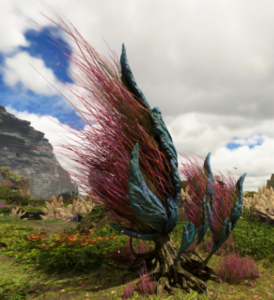
 Not only are the fruits of tìhawnuwll edible, but so are their smaller lower leaves, which are used for leaf wraps. The upper leaves are harvested for mats.
Not only are the fruits of tìhawnuwll edible, but so are their smaller lower leaves, which are used for leaf wraps. The upper leaves are harvested for mats.
To sustain their salt needs, Na’vi eat bladder polyps, or rawp, and the salty leaves of the puffball tree, or rumut (both right). The rumut is a tree with ball-shaped structures covered in blue or orange leaves. Rawp are juicy, ground-dwelling succulents that taste somewhat like a pickle.
Spiny whips (left), or pxayzekwä, ‘many fingers’, eject small, succulent, finger-shaped pieces of tissue, which are collected and eaten.
 The leaves and also the roots of the delta tree (right), or apxangrr, are known food for the Na’vi. They have learned to strip off the lower leaf epidermis, which contains poison glands, and harvest the tasty insides of the leaves.
The leaves and also the roots of the delta tree (right), or apxangrr, are known food for the Na’vi. They have learned to strip off the lower leaf epidermis, which contains poison glands, and harvest the tasty insides of the leaves. Roots that have not been contaminated by the poisonous roots of any neighboring unidelta trees are peeled, ground up, and used for flour.
Roots that have not been contaminated by the poisonous roots of any neighboring unidelta trees are peeled, ground up, and used for flour.
To make flour, or tsyo, Na’vi use mashing poles. The cycad (left), known to the Na’vi as tsyorina’wll, ‘flour seed plant’, is the main source of tsyo. Its seeds are soaked first to remove nerve toxins before being ground into flour. Tsyo is also made from seeds of the hermit bud (below), or pxiwll, and are a good source of protein and oil.



Seeds of the deadly and toxic banshee of paradise plant (left), or awaiei, are highly desirable to the Na’vi. The awaiei is deadly because it shoots poison-tipped spines as defense, although the seeds are attached on the stem opposite to the direction the plant is pointing, making it easy for the Na’vi to harvest them.
The episoth (right) and sari—pxorna’ and pxorna’lor—are plants that disperse their seeds in an explosive way. Animals and Na’vi have learned to recognize the sounds of this explosion and come to collect seeds to eat. The seeds are delicious and are used as a high protein source. The large seeds of the lionberry, or kllpxiwll, are also a high source of protein.
 The seeds of the thistle bud (left), or fkxakewll, are large and edible and used as a food staple for the Na’vi. They are harvested very carefully to avoid contacting the glands on the plant surface that cause unbearable itching on contact. An easy harvest method is to wait until the seeds are mature and whack the stem below the inflorescence with a stick, causing it to fall to the ground where the seeds can then be collected. Whoever is collecting seeds often has to compete with animals that also find them a valuable food.
The seeds of the thistle bud (left), or fkxakewll, are large and edible and used as a food staple for the Na’vi. They are harvested very carefully to avoid contacting the glands on the plant surface that cause unbearable itching on contact. An easy harvest method is to wait until the seeds are mature and whack the stem below the inflorescence with a stick, causing it to fall to the ground where the seeds can then be collected. Whoever is collecting seeds often has to compete with animals that also find them a valuable food.
 Specific to the Western Frontier, the roots of the sunflower gigantus, or ko’onspul, although very bitter, can be cooked and eaten.
Specific to the Western Frontier, the roots of the sunflower gigantus, or ko’onspul, although very bitter, can be cooked and eaten.
In the region’s Upper Plains, the seed of the feather blade, or yawrwll (right), is edible and extremely palatable to the Na’vi, who use the large and starchy nut in several cooking applications.
 The seed of the cloud spitter, or hiupwopx, is a staple for the Zeswa and wise harvesters can predict where ejected seeds can be found and easily gathered.
The seed of the cloud spitter, or hiupwopx, is a staple for the Zeswa and wise harvesters can predict where ejected seeds can be found and easily gathered.
The spores of the banshee’s tail, or kxetsikran, can be collected and, when dried, used in food for its subtly floral flavor. The spores also have an effect on Na’vi metabolism and help digestion and the release of energy in both dried and raw form.
Over in the Frontier’s Clouded Forest, the nutritious seeds of the eyethorn, or naritxim (left), which are waxy in texture and are mainly purple with some green stripes, are used for cooking a variety of dishes. Naritxim are a coveted gathering challenge for young Kame’tire who enjoy chewing on the raw seeds. Gaining scratches from the thorny plant while gathering is considered a rite of passage, a lesson about improving their skills before putting themselves in harm’s way.